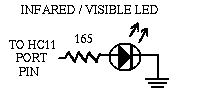
LED stands for Light Emmiting Diode. An LED is a translucent plastic bulb with two wires sticking out of the bottom. LEDs come in many colors, including infared, and emit light when put a voltage accross their leads in the right direction.
LEDs are great light sources because they are tough, light up instantly, and require relatively low current. Since they are diodes, they pass current only in one direction, from anode to cathode.
It's a quantum thing. Take 8.04.
The following schematic shows the basic circuit.

Attach the circuit to one of the HC11's port pins. If you are using the LED for, you must attach it to port PA6.
You should be careful to limit the current through the LED to a safe level by using a series resistor. (In the above schematic, the 240 ohm resistor is the series resistor.)
Typically, you would like to keep the current to about 20-30 milliamps. This current is determined by the value of the series resistor. You can use the following formula to determine R, though 165 ohms works in most cases.
R = (Vin-Vled) / Iled

An LED has two pins, called the anode and the cathode. The anode is the positive pin, and the cathode is the negative pin. The LED symbol's arrow points towards the cathode.
There are two ways to identify LEDs. Right out of the box, the longer lead is the andode, and the shorter lead is the cathode. Mutilated or in a circuit, the side of the LED's bezel that is flat is the side nearest the cathode. This flat area is called the "cathode mark."
If the LED gets very hot, blows up, or starts to smoke, disconnect it immediately! If the LED does any of these things, you either put too much current through it or put it in backwards.